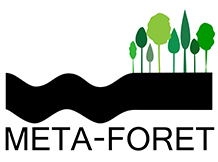2/ Locally-resonant metamaterials : numerical work around the meta-forest
In the second type of metamaterial we make full use of the hybridization effect created by the local resonance phenomena. Starting from the results already obtained on plates with a cluster of closely spaced rods in frequency between 1 and 10 kHz, we extend it to the more complex case of resonators (trees) on a sedimentary halfspace in the 20-100 Hz frequency range. Preliminary simulations on a 2D model (Fig. 1a) have shown that elastic rods attached to a bulk elastic substrate can easily approximate trees and that a cluster of elastic rods (hence a forest) shows a Rayleigh dispersion curve characterized by the same exotic phenomena (repeated bandgaps, slow and fast waves) found in the plate for flexural waves (section "scientific challenges" Fig. 1). The richer physics characterizing the half space allows the creation of the meta-wedge a device that is able to convert Rayleigh waves into shear waves (Fig. 1b).

(b) The meta-wedge capable of converting Rayleigh waves into shear waves.
Results have been obtained in 2D so far (Colombi et al, 2015) ; therefore the main challenge in this phase is to move to a full 3D geometry. Numerically this is obtained using geometry decomposition and an adaptive meshing technique. An automated meshing procedure will generate a cluster of resonators with varying height to test a metamaterial with variable refraction index that can detour Rayleigh waves. The same technique will be used to implement and study the performance of the meta-wedge in 3D. In an actual field experiment this would be very problematic, as it would require having access to the seismic field in depth. These simulations will allow studying the effect of the spatial density of the resonator distribution that is otherwise very difficult to anticipate both analytically and experimentally.
Updated on 5 octobre 2016


